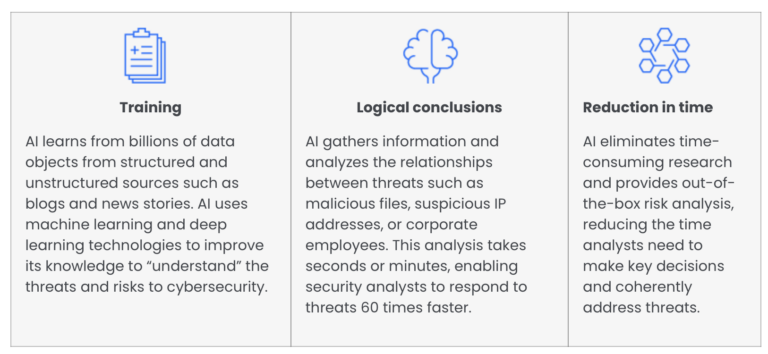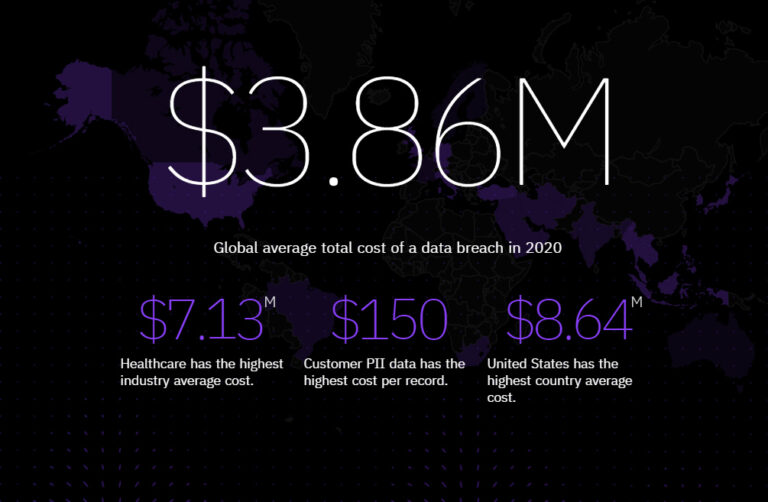Obsah
Artificial intelligence (AI) has tremendous potential in cybersecurity, a rapidly growing field. Businesses are worried about growing cyber threats, and rightly so: just one successful malware attack can cause a lot of financial, reputational, and legal damage, even stopping a business. But thanks to advanced AI-powered cloud security, the future looks much more promising for businesses than for cybercriminals.
Cybercriminals don’t need to be technical experts today. Artificial intelligence allows them to use specific automated tools that can be trained in the process. It has already become common for malware to set a time interval, after which it will manifest its malicious activity – it can be minutes or even days after the file has been declared safe.
Some businesses with limited security resources are likely to be the most vulnerable. Everyone is at risk as AI-based ransomware, and other forms of malware are incredibly efficient at spreading and hitting targets with precision. The AI war, which is industrial and political espionage and intelligence gathering, is another growing threat. Even the German parliament has suffered from such cyber operations.
The biggest lesson to be learned from this is that many traditional security measures are no longer good enough. Artificial intelligence works just like the human brain: it learns, develops, and grows. No firewall or built-in virus checking program can compete with this.
According to the FBI’s 2020 Internet Crime Report, the number of cybercrimes increased by 61% compared to the previous year. The total damage was $ 4.2 billion.
AI, Machine Learning, and Deep Learning in Cybersecurity
In the foreseeable future, machine learning AI will become an essential cybersecurity tool. And although at present, cybersecurity still largely depends on the work of specialists, machines are gradually taking the lead in solving specific problems.

Technological optimisation makes the human role in the field of security more effective. These developments relate to the following main areas.
Artificial intelligence
AI is designed to fully endow the machine with the ability of the human mind to respond. It is a core discipline encompassing many others, including machine learning and deep learning.
Machine learning
ML is a process in which a computer, using specialised technological tools, can study and use new data without mandatory human intervention. Sophisticated algorithms allow a digital platform to process and “understand” data from vast repositories of information to reach certain conclusions and discover patterns.
The system analyses these patterns, groups them according to certain criteria, and then makes conclusions or assumptions. In traditional machine learning, a computer learns to decode information that people have already categorised and labelled. Machine learning is the most relevant discipline in AI-powered cybersecurity today.
Deep learning
DL is another level of our pyramid since it is a subset of machine learning. The main difference between them is that deep learning uses neural networks, a complex structure of algorithms, the creation of which was inspired by a human brain. It’s a more advanced technology that doesn’t require specific instructions from programmers to learn from data. Currently, deep learning in cybersecurity belongs to the realm of machine learning, so we will mainly focus on this broader area.
The role of Machine Learning in cybersecurity
Security software using machine learning technologies is different from the traditional concept of artificial intelligence. This approach uses data templates to determine the likelihood of an event.
It means that the algorithm operates by learning from a dataset focused on a specific task. Its job is to find the best way to accomplish a given task. ML will strive to find a solution that is the only one possible based on the available data.

Machine learning technologies are great at tackling repetitive tasks, such as identifying patterns in data and validating them. But humans have to interpret the data, while machine learning helps bring the data into a readable and analytic form.
The more this program repeats the cycle of recognising and assigning categories to patterns to conclude them, the better it “understands” how it can be done on its own, without human help or additional scripts written by people.
You can come across many different machine learning algorithms, but they all usually perform one of the following tasks in cybersecurity.
Regression
Finds correlations between different datasets and understands how they relate to each other. You can use regression to predict operating system calls and then identify anomalies by comparing the forecast with the actual request.
Clustering
Analyses datasets and groups them based on the general characteristics of this data. Clustering works directly with new data without considering the previous examples.
Classification
In this approach, algorithms are trained from previous observations and try to apply the knowledge gained to new data. Classification involves taking artefacts and classifying them under one of several labels. For example, categorise a binary file into categories such as legitimate software, adware, or ransomware.
Recommendations for further action
These guidelines will help you improve the effectiveness of your machine learning security controls. They are inferred based on behavior patterns and previous decisions. In other words, it is an adaptive system capable of building logical relationships based on available data. Such tools can help with threat response and risk management.

- The synthesis of possibilities allows you to get completely new results based on historical and new datasets. This approach allows for a better determination of the probabilities of repeating past states of the system. For example, synthesis can be used to investigate vulnerabilities in an organisation’s systems proactively.
- Forecasting is the most advanced of the machine learning processes. Potential outcomes are determined by evaluating existing datasets. Forecasting can be used primarily for threat modeling, fraud prevention, and data loss protection.
Benefits of Artificial Intelligence in Cybersecurity
AI technologies such as machine learning and natural language processing enable analysts to respond faster and more confidently to threats.

It is important to note that AI can perform essential functions: centralised processing, power redundancy, internal temperature, and cooling filters. This way, you can optimise costs with AI. AI can help keep track of hardware failures. AI alerts let you quickly troubleshoot hardware problems.
Want to know more about the benefits of machine learning for your business? Check out our article Top 5 Business Benefits of Machine Learning
Use Cases of AI / Machine Learning in Cybersecurity
Machine learning allows you to view volumes of data and analyse them using statistics quickly. In modern business, a considerable amount of information appears every day, so technology’s introduction helps to cope with this.
AI-based User Behavior Modeling
Some types of cybersecurity attacks that target corporate systems are carried out by stealing data from specific users in an organisation. Malicious users disguised as users penetrate the system and gain access to the corporate network in technically legal ways, which means that their trail is challenging to detect and stop. AI-based cybersecurity systems can recognise the behaviour patterns of specific users to detect changes in their behaviour patterns. In other words, technology notifies the security team when this happens.
Darktrace has implemented a cybersecurity solution that uses machine learning to analyse network traffic’s raw data to understand the baseline level of the normal behaviour of every user and device in an organisation. The software learns by using training datasets and raw data from experts to distinguish between significant deviations and normal behaviour and immediately alert the organisation to cyber threats.
The best thing about implementing AI concepts is that companies can reduce their cost by 12% in terms of threats and breach detection. In addition to this, they can follow use cases of AI to improve their performance cybersecurity-wise.
AI For Fighting AI Threats
Today, for the security of companies, it is crucial to increase the detection of cyber threats because hackers now use AI to find weak points through which they can penetrate corporate networks. Thus, deploying AI software to defend against AI hacking attempts can become a necessary part of tamper-proof protocols.
Over the past several years, companies around the world have come under cyber and ransomware attacks. Imagine that in the first half of 2020, companies incurred losses of $ 3.86 billion.

Falcon Platform is a digital security solution that uses AI to defend against ransomware threats like WannaCry and others. The software is reported to identify anomalies to ensure endpoint security on corporate networks.
AI for identifying online threats
Protecting corporate networks is critical to your business. It is essential to understand all the elements involved in the network topography to provide genuinely high network security. For cybersecurity professionals, this means keeping track of all communications in and out of the enterprise network.
Managing the security of these corporate networks includes determining which connection requests are legitimate and attempting to exploit unusual connection behaviour.
The challenge for cybersecurity experts is to determine which parts of an application, be it the web, mobile platforms, or applications in development or testing, might be malicious.
eSentire offers an AI-powered enterprise cybersecurity software called the VSE Versive Security Engine. They claim can help banks and financial institutions analyse large datasets of transactional and cybersecurity-related data using machine learning.
Versive uses banks NetFlow (a network protocol developed by Cisco for collecting IP traffic information and monitoring network traffic), proxy server, DNS data (computer network data) as input to the Versive Security Engine. The digital solution can also monitor corporate networks using anomaly detection, which is similar to the events in past cyber threats.
IDC expects worldwide security spending to reach $174.7 billion in 2024, with a compound annual growth rate (CAGR) of 8.1% over the 2020-2024 forecast period.
Záverečné slová
The use of artificial intelligence in cybersecurity is more of an innovation than something generally accepted. Some companies are improving their systems with cybersecurity specialists, who, in turn, are working on software to identify cyberattacks more accurately.
It is essential to understand that you will receive a system that is as good as the quality information you provided for training it.
Some multinational companies already have a team of specialists in cybersecurity, IT infrastructure, and budgets to develop products for working with massive data.
ČASTO KLADENÉ OTÁZKY
AI improves cybersecurity by automating threat detection, identifying patterns in large datasets, and flagging potential risks faster than humans. It’s applied in areas like malware detection, anomaly detection, network security, and even in preventing phishing attacks. AI can learn from historical data and adapt its defenses over time, helping to mitigate evolving threats.
AI won’t completely replace human involvement in cybersecurity, but it will continue to play a key role in automating many aspects of threat detection and prevention. While AI can handle repetitive tasks and detect anomalies, human expertise is still needed for strategic decision-making, interpreting complex threats, and understanding the context behind security breaches.
AI is increasingly being adopted in cybersecurity across industries. Many companies rely on AI-driven solutions to monitor network traffic, analyse large volumes of data, detect anomalies, and respond to potential threats. As cyber attacks become more sophisticated, AI’s role in cybersecurity is only expected to grow.
Yes, AI can predict cyber attacks by analysing past behaviour and detecting patterns that could indicate a potential threat. Machine learning algorithms can assess data in real-time to recognise abnormal patterns and predict potential attacks before they happen, allowing organisations to take proactive measures to protect their systems.
Responsible AI in cybersecurity refers to the ethical development and deployment of AI systems. This includes ensuring transparency, fairness, accountability, and minimising biases in AI algorithms. Responsible AI should prioritise privacy and ensure that security solutions do not inadvertently cause harm or infringe on users’ rights.
Machine learning uses existing behaviours to make decisions based on available data and inferences. Based on this, we can say that machine learning does an excellent job with monotonous tasks in which a person may have a blurred eye effect. Also, one of the main advantages of ML is the speed at which it detects and responds to cyber-attacks. However, human intervention is still required to make the necessary corrections since the pedestrians are trained, and it is essential to monitor the algorithm to ensure that it works correctly.



